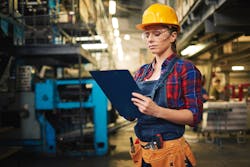Biden Tax Credits, Trump Tariffs Together Boost US Manufacturing
COMMENTARY
Over the past five years, Washington has enacted two sets of policies to stimulate domestic manufacturing production: tariffs and tax credits. The Trump administration favored tariffs, while the Biden administration is using tax credits. Both policies are now working to bring manufacturing back to the U.S.
Tariffs Prompt Production Shifts
The Trump administration’s Section 301 tariffs on Chinese imports have already reduced America’s dependence on China. Between 2017 and 2022, imports to the U.S. worldwide rose by 39%, while imports to the U.S. from China rose by only 6%. In some categories, China imports fell dramatically. For example, in luggage, China’s share of U.S. imports dropped from 58% to just 25%. In total, the Section 301 tariffs diverted $164 billion of U.S. imports from China to other source nations. That reduced America’s dependence on China and weakened China’s ability to grow its economy.
Some U.S. manufacturers have moved production out of China and back to the U.S. For example, Generac, a maker of power generators, has shifted production to a new factory in Trenton, South Carolina, set to employ up to 750 employees. Williams Sonoma—the owner of retailers Pottery Barn and West Elm—has shifted from overseas to U.S. suppliers for some of its products. And a survey reported by Bloomberg News found that 90% of U.S. executives were planning to move production out of China, with 80% of them considering some production in the U.S.
However, the China tariffs have not led to large volumes of reshoring. For that, it’s better to look at the global tariffs implemented by the Trump administration. Washing machine tariffs imposed in 2018 led South Korea’s two large manufacturers, Samsung and LG Electronics, to build new U.S. factories. Samsung built a plant in Newbury, South Carolina; LG built a facility in Clarksville, Tennessee. Each facility today employs roughly 1,000 people.
In the steel industry, the results have been even bigger. A March report by the bipartisan U.S. International Trade Commission found at least 16 new steel facilities announced since the 2018 steel tariffs. These include new mills in Florida, West Virginia, Texas, and Arizona. SEC filings show that the average annual pay at a major U.S. steelmaker is $124,000. Working in the steel industry is one of the best opportunities for those without a four-year college degree. These new steel mills are providing good jobs for thousands of people.
Tax Credits Encourage Investment
The Biden administration’s tax credit policies have also had positive effects on manufacturing industries. Last year’s CHIPS Act allocated $39 billion worth of tax credits spread over 10 years to help microchip manufacturers establish U.S.-based fabrication facilities. This has initiated roughly $150 billion in investments that could create 20,000 direct jobs. That’s a boon for Ohio, where Intel is building a large fab complex. Upstate New York is also expecting a new Micron operation; Arizona is preparing for a new TSMC plant.
Similarly, the tax credits in last summer’s Inflation Reduction Act (IRA) have initiated sizable investments in solar equipment manufacturing. The two largest U.S. producers of solar modules, First Solar and Hanwha Q Cells, have each committed to billion-dollar investments for new production facilities in Ohio, Georgia and Alabama. Industry analysts forecast that by 2030, the U.S. could be producing the majority of solar modules it consumes, and half of the solar cells for these modules.
Even more impressive is the IRA’s provisions for electric vehicles (EVs) and batteries. Those tax credits have spurred ambitious plans by automakers and others for new facilities, including a Hyundai plant in Georgia for batteries and EVs that will employ 8,000, and a Panasonic battery production facility that will employ 4,000. GM, Ford, Stellantis and Tesla also have announced plans to expand U.S.-based EV and battery production.
The Two Work in Tandem
In comparing the two policies, tariffs work effectively to block unfairly subsidized imports from China. They also benefit all American producers, allowing competition within the U.S. to thrive—holding down prices when production expands.
Tax credits have the advantage of certainty. Automakers are investing in EVs because the IRA guarantees them billions in tax credits.
Tariffs always come with a question mark, because many nations have proven resourceful at evading them. But tax credits do cost taxpayers billions of dollars, and there’s no plan for when the current credits expire.
America’s current manufacturing boom looks set to continue and grow over the next several years, with benefits for U.S.-based companies. This will boost U.S. jobs and increase America’s industrial self-sufficiency.
Jeff Ferry is chief economist at the Coalition for a Prosperous America. Twitter: @menloferry.
